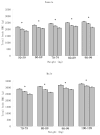Relationship of obesity with osteoporosis
- PMID: 17299077
- PMCID: PMC1868430
- DOI: 10.1210/jc.2006-0572
Relationship of obesity with osteoporosis
Abstract
Context: The relationship between obesity and osteoporosis has been widely studied, and epidemiological evidence shows that obesity is correlated with increased bone mass. Previous analyses, however, did not control for the mechanical loading effects of total body weight on bone mass and may have generated a confounded or even biased relationship between obesity and osteoporosis.
Objective: The objective of this study was to reevaluate the relationship between obesity and osteoporosis by accounting for the mechanical loading effects of total body weight on bone mass.
Methods: We measured whole body fat mass, lean mass, percentage fat mass, body mass index, and bone mass in two large samples of different ethnicity: 1988 unrelated Chinese subjects and 4489 Caucasian subjects from 512 pedigrees. We first evaluated the Pearson correlations among different phenotypes. We then dissected the phenotypic correlations into genetic and environmental components with bone mass unadjusted or adjusted for body weight. This allowed us to compare the results with and without controlling for mechanical loading effects of body weight on bone mass.
Results: In both Chinese and Caucasian subjects, when the mechanical loading effect of body weight on bone mass was adjusted for, the phenotypic correlation (including its genetic and environmental components) between fat mass (or percentage fat mass) and bone mass was negative. Further multivariate analyses in subjects stratified by body weight confirmed the inverse relationship between bone mass and fat mass, after mechanical loading effects due to total body weight were controlled.
Conclusions: Increasing fat mass may not have a beneficial effect on bone mass.
Figures

Similar articles
-
Association of body composition with bone mineral density in northern Chinese men by different criteria for obesity.J Endocrinol Invest. 2015 Mar;38(3):323-31. doi: 10.1007/s40618-014-0167-5. Epub 2014 Sep 25. J Endocrinol Invest. 2015. PMID: 25252817
-
Relationship of body composition with bone mineral density in northern Chinese men by body mass index levels.J Endocrinol Invest. 2014 Apr;37(4):359-67. doi: 10.1007/s40618-013-0037-6. Epub 2014 Jan 30. J Endocrinol Invest. 2014. PMID: 24477947
-
Relationship of sarcopenia and body composition with osteoporosis.Osteoporos Int. 2016 Feb;27(2):473-82. doi: 10.1007/s00198-015-3241-8. Epub 2015 Aug 5. Osteoporos Int. 2016. PMID: 26243357
-
The different correlations between obesity and osteoporosis after adjustment of static mechanical loading from weight and fat free mass.J Musculoskelet Neuronal Interact. 2021 Sep 1;21(3):351-357. J Musculoskelet Neuronal Interact. 2021. PMID: 34465673 Free PMC article.
-
Correlation of obesity and osteoporosis: effect of fat mass on the determination of osteoporosis.J Bone Miner Res. 2008 Jan;23(1):17-29. doi: 10.1359/jbmr.070813. J Bone Miner Res. 2008. PMID: 17784844 Free PMC article. Review.
Cited by
-
Associations of SAA1 gene polymorphism with lipid lelvels and osteoporosis in Chinese women.Lipids Health Dis. 2013 Mar 22;12:39. doi: 10.1186/1476-511X-12-39. Lipids Health Dis. 2013. PMID: 23522429 Free PMC article.
-
The Association between Obesity and Reduced Weight-Adjusted Bone Mineral Content in Older Adults: A New Paradigm That Contrasts with the Obesity Paradox.Nutrients. 2024 Jan 25;16(3):352. doi: 10.3390/nu16030352. Nutrients. 2024. PMID: 38337637 Free PMC article.
-
Low bone density, vertebral fracture and FRAX score in kidney transplant recipients: A cross-sectional cohort study.PLoS One. 2021 Apr 30;16(4):e0251035. doi: 10.1371/journal.pone.0251035. eCollection 2021. PLoS One. 2021. PMID: 33930070 Free PMC article.
-
Effect of fat mass and lean mass on bone mineral density in postmenopausal and perimenopausal Thai women.Int J Womens Health. 2013;5:87-92. doi: 10.2147/IJWH.S41884. Epub 2013 Feb 27. Int J Womens Health. 2013. PMID: 23467695 Free PMC article.
-
The effects of sarcopenia and obesity on femur neck bone mineral density in elderly Korean men and women.Osteoporos Sarcopenia. 2016 Jun;2(2):103-109. doi: 10.1016/j.afos.2016.04.002. Epub 2016 May 18. Osteoporos Sarcopenia. 2016. PMID: 30775475 Free PMC article.
References
-
- Kanis JA, Melton LJ, III, Christiansen C, Johnston CC, Khaltaev N. The diagnosis of osteoporosis. J Bone Miner Res. 1994;9:1137–1141. - PubMed
-
- Guney E, Kisakol G, Ozgen G, Yilmaz C, Yilmaz R, Kabalak T. Effect of weight loss on bone metabolism: comparison of vertical banded gastroplasty and medical intervention. Obes Surg. 2003;13:383–388. - PubMed
-
- Radak TL. Caloric restriction and calcium’s effect on bone metabolism and body composition in overweight and obese premenopausal women. Nutr Rev. 2004;62:468–481. - PubMed
-
- Wardlaw GM. Putting body weight and osteoporosis into perspective. Am J Clin Nutr. 1996;63:433S–436S. - PubMed
Publication types
MeSH terms
Grants and funding
LinkOut - more resources
Full Text Sources
Medical

